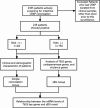The type VI secretion system as a potential predictor of subsequent bloodstream infection of carbapenem-resistant Klebsiella pneumoniae strains on intestinal colonization
- PMID: 39899211
- PMCID: PMC11971171
- DOI: 10.1007/s15010-024-02456-x
The type VI secretion system as a potential predictor of subsequent bloodstream infection of carbapenem-resistant Klebsiella pneumoniae strains on intestinal colonization
Abstract
Background: The type VI secretion system (T6SS) has been recognized as a novel virulence factor in Klebsiella pneumoniae. This study investigated the occurrence of T6SS genes in carbapenem-resistant Klebsiella pneumoniae (CRKP) strains during intestinal colonization and evaluated their effect on the development of bloodstream infections.
Methods: The study encompassed 2,385 patients admitted to the intensive care unit (ICU) and subjected to routine screening for intestinal colonization with CRKP. PFGE was employed on CRKP strains isolated from both the patients' intestine and blood cultures, confirming their genetic similarity. PCR was employed to detect the presence of carbapenemase genes, T6SS genes, and virulence genes. Quantitative real-time PCR was conducted to assess the expression levels of the core genes associated with the T6SS. The correlation between T6SS expression and sBSI was further investigated.
Results: Approximately 10% (238/2385) of ICU patients tested positive for CRKP colonization. Among patients who tested positive, 10.1% (24/238) developed CRKP-sBSI. Patients carrying T6SS-positive CRKP isolates were more commonly linked to a history of invasive procedures, antibiotic use, and immunosuppression (P < 0.05), and were strongly associated with 28-day mortality (P < 0.001). It indicated that T6SS-positive CRKP strains exhibited a higher prevalence of virulence genes, such as rmpA and iucA, compared to T6SS-negative ones (P < 0.001). Compared to the strains isolated from simple colonization group, there was a significant increase in the mRNA expression of both hcp and vgrG genes (P < 0.05) of strains from the sBSI group, suggesting the key genes of the T6SS may play a significant role in the occurrence and progression of sBSI caused by CRKP.
Conclusion: The presence of the T6SS in a CRKP strain from intestinal colonization can serve as a promising predictive marker for sBSI. Conducting screenings for CRKP in patients' intestinal flora and monitoring T6SS carriage can improve the prevention and management of CRKP bloodstream infections.
Keywords: Active screening; Carbapenem-resistant Klebsiella pneumoniae; Intestinal Colonization; Subsequent Bloodstream Infection; Type VI secretion system.
© 2024. The Author(s).
Conflict of interest statement
Declarations. Ethics approval and consent to participate: This study was approved by the Institutional Review Board and Ethics Committee of The First Affiliated Hospital of Sun Yat-sen University and conducted according to the Declaration of Helsinki(Approved No. of ethics committee: [2024]-200). The ethics committee approved the waiver of informed consent owing to the retrospective nature of the review. All research data were de-identified and anonymously analyzed. Consent for publication: NA. Competing interests: The authors declare no competing interests.
Figures





Similar articles
-
Study on the correlation between carbapenem-resistant Klebsiella pneumoniae infection strains and intestinal colonization strains in intensive care unit of a tertiary hospital in China.J Glob Antimicrob Resist. 2025 Jun;43:327-336. doi: 10.1016/j.jgar.2025.05.004. Epub 2025 May 19. J Glob Antimicrob Resist. 2025. PMID: 40398678
-
Molecular epidemiology and clinical characteristics of carbapenem-resistant Klebsiella pneumoniae bloodstream and pneumonia isolates.Microbiol Spectr. 2025 Aug 5;13(8):e0063125. doi: 10.1128/spectrum.00631-25. Epub 2025 Jul 9. Microbiol Spectr. 2025. PMID: 40631745 Free PMC article.
-
Carbapenem-resistant Klebsiella pneumoniae gut colonization and subsequent infection in pediatric intensive care units in shanghai, China.Ann Clin Microbiol Antimicrob. 2025 Jul 3;24(1):39. doi: 10.1186/s12941-025-00808-5. Ann Clin Microbiol Antimicrob. 2025. PMID: 40611292 Free PMC article.
-
Incidence and risk factors for subsequent infections among rectal carriers with carbapenem-resistant Klebsiella pneumoniae: a systematic review and meta-analysis.J Hosp Infect. 2024 Mar;145:11-21. doi: 10.1016/j.jhin.2023.12.002. Epub 2023 Dec 12. J Hosp Infect. 2024. PMID: 38092302
-
Systematic review and meta-analysis of mortality of patients infected with carbapenem-resistant Klebsiella pneumoniae.Ann Clin Microbiol Antimicrob. 2017 Mar 29;16(1):18. doi: 10.1186/s12941-017-0191-3. Ann Clin Microbiol Antimicrob. 2017. PMID: 28356109 Free PMC article.
References
-
- Hu F, Wang M, Zhu D, et al. CHINET efforts to control antimicrobial resistance in China. J Glob Antimicrob Resist. 2020;21:76–7. - PubMed
-
- Zhang H, Han J, Wang Z, et al. Research progress on pathogenesis, antimicrobial resistance mechanism, and treatment of hypervirulent Klebsiella pneumoniae. Chin J Pathogen Biology. 2024;19(10):1239–43. 10.13350/j.cjpb.241025.
MeSH terms
Substances
Grants and funding
LinkOut - more resources
Full Text Sources
Miscellaneous

